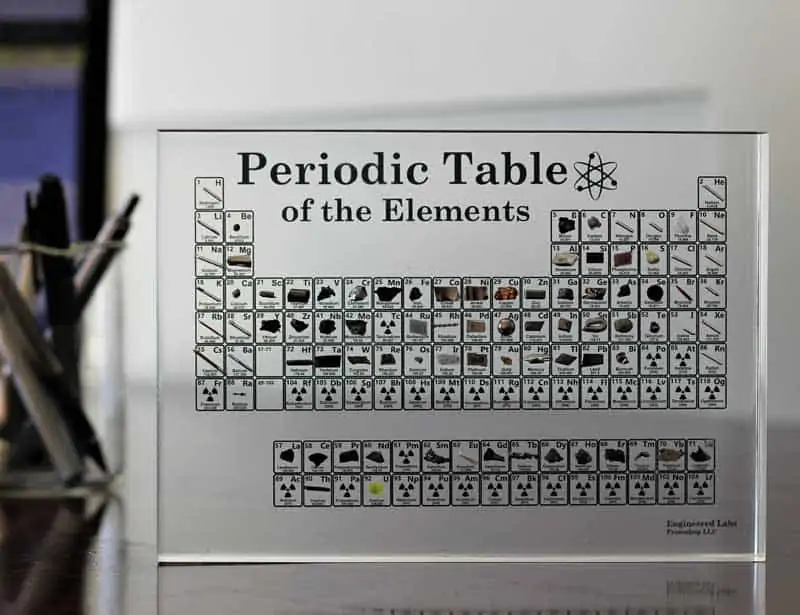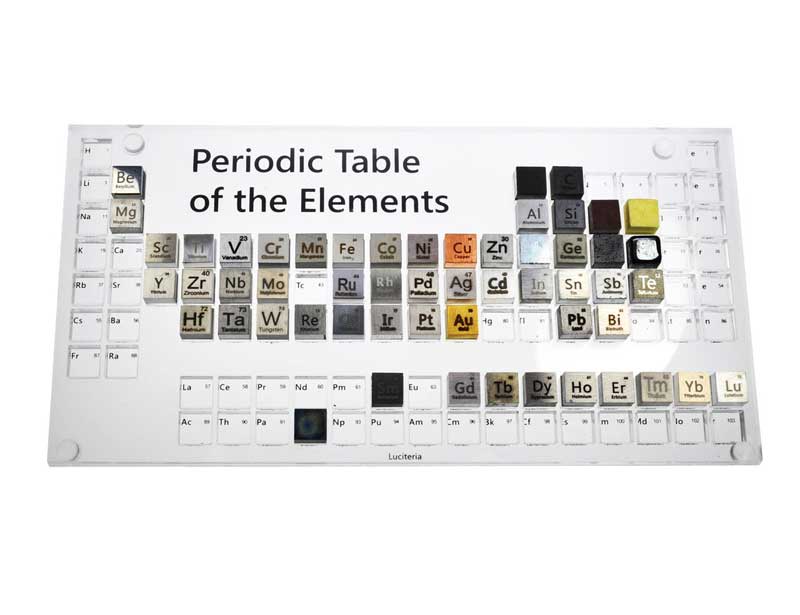Periodic Table with Real Elements Choices for Science Learning
The periodic table is an organized tabular display of chemical elements. We also know it as the periodic chart or periodic table of elements. Rather than settling for a paper or chart display, today, we can even proudly display on our bookshelves a periodic table with real elements.
In schools and laboratories worldwide, the standard grid and labeling of elements throughout the periodic table remain the same. Widely used in the sciences - chemistry, physics, and biology - this display is an important tool in our world as it helps us understand the properties of real elements.
But as humans continue to embrace innovation, many companies have taken the periodic table as we know it to the next level. Chemistry lovers, science enthusiasts, students, and teachers will appreciate the fascinating display with actual elements.
History of the Periodic Table
The periodic table is an important tabular arrangement. You’ll find it on classroom walls, between textbook pages, in libraries, etc. Science lovers and budding scientists will also proudly display the table in their homes as a statement piece reflecting their passion and interest.
Its function goes beyond helping people name and identify the elements. Science geeks and scientists use the table to understand trends in the properties of real elements. Apart from that, they also use it to understand chemical reactions and analyze reactivity.
Before we got to this stage of experiencing a periodic table with actual samples, the development had gone through many stages.
We recognize the Russian scientist Dmitri Mendeleev as the inventor of the periodic table framework as we know it today. He achieved this in 1869. At the time of creation, Mendeleev left spaces for elements we had not yet discovered.
Although we credit the modern table display to this scientist, there’s a difference in the display from that period. Mendeleev arranged the elements based on atomic weight. However, today’s table displays elements based on increasing atomic numbers.
Exploring the periodic elements
Before Mendeleev, various chemists observed similarities between elements based on their properties. In 1789, Antoine Lavoisier, a French chemist, started to group elements as metals and non-metals. In the early 1800s, Johann Dobereiner observed that some elements had similar physical and chemical properties. As a result of this observation, he arranged the elements in groups of three called triads.
There were problems with this classification as it didn’t apply to all elements. In 1865, British chemist John Newlands conceived a formula to arrange elements based on the increasing order of their atomic masses. He called this the law of octaves because he stated that every eight elements had similar properties. Newlands left no room for elements that were yet to be discovered.
It wasn’t until after Mendeleev that the real development of the periodic table as an object for display began. In periodic tables, the rows are periods, and the columns are groups. For the longest time, periodic tables were two-dimensional items, like charts. However, turning our interest in science and a little history, with development, you can now get periodic tables with samples of elements.
With real element samples, you can use visual cues to understand their properties better.
3 Best Periodic Tables with Actual Real Elements Inside
Are you looking to buy a great-quality periodic table? Then you should consider a periodic table with real elements.
Rather than settling for the regular chart, these three-dimensional options are the real deal and are worth it. You can examine the real pieces through visual cues. Plus, this option makes a beautiful piece to add to your table or shelf display.
Furthermore, any periodic tables we’ve listed make the perfect gift for the young budding scientist or curious explorer of our natural world.
Side note: A quick browse online, and you'll find a load of what appear to be copy-cat periodic tables. We've avoided these and recommend you do, too, supporting the creators of the real deals listed below.
1. Engineered Labs Heritage Table with Elements

This brand sets itself apart by not only producing a quality product but also one that’s locally made. Many periodic tables in the market are produced in China. However, this company locally produces its products in the United States. Furthermore, they were the first to produce an acrylic periodic table with real elements.
The product comprises 83 stable pure elements and measures 114mm x 152.4mm x 25.4mm. The process involves breaking, cutting, melting, or smashing the elements to ensure they fit within the display. There are 83 elements contained in the display. Although there are no highly radioactive elements, you can still explore their information. You’ll also find noble gases represented by pure bubbles.
To guarantee its highest quality, the brand includes a certificate of authenticity in the package. This certificate contains details about each sample or element.
During production, the workers carefully place each element on the acrylic material. You should note that some elements, like alkali metals, are in compound form.
The Original Periodic Table Created with Safety In Mind
Many people have concerns about the safety of keeping these periodic tables because of dangerous elements. Due to these concerns, this company is transparent about its processes. You’ll find pure samples of stable elements like hydrogen, oxygen, helium, and many others within the display. However, many other elements are represented with impure samples. This is a result of their reactive nature.
2. Luciteria Science Periodic Table with Real Elements Collection

Luciteria Science’s desk displays the periodic table and comes with real sample elements. The company takes pride in using innovative ways to transform two-dimensional periodic tables into something more exciting.
As a result, the company offers various options that allow you to interact with real samples of elements. Since acquiring elements alone can be expensive, this is an accessible, safe, and affordable way to obtain element samples.
Luciteria Science’s Density Cube Set is the perfect collector’s item. The super-cool collection includes a display case to arrange the real samples. The acrylic tray has 14mm slots that hold the brand’s 10mm cubes.
The brand takes a DIY approach to its offering by allowing you to choose the cube sets you want to purchase. With the Lucite acrylic art cubes, the company embeds each element sample in pure Lucite acrylic.
Collect Real Element Samples in Different Formats
What makes this brand stand out from others is that it gives you the option to obtain your element samples however you like. The brand offers density cubes, Lucite acrylic art cubes, element rounds, and bullions. By interacting with the elements, you get an enhanced learning experience.
Shop Density Cube Set on Amazon or on Luciteria
3. PEguys Periodic Element Acrylic Display

PEguys (Periodic Element Guys) tags this offering as a ‘young scientist edition.’ The name is quite befitting as this fantastic product is the perfect addition to any young scientist’s possessions. Also, it makes the ideal gift for any student who loves science or budding enthusiast pursuing a career in the field.
This standard display comes with 72 tiles containing real elements inside. The set includes 4 gases and all 16 rare earth metals. The company contained the 4 alkalies in glass ampoules to adhere to safety measures, which they further covered with resin.
The structure of this design enables you to place the acrylics containing real samples on the large display. The display measures 594mm x 420mm, while the crystal clear acrylic tiles are 29mm x 26mm x 6mm. To ensure it is of high quality, the company uses 4 sheets of acrylic material to produce the display. This gives you a thickness of 6mm.
This product provides a visually pleasing, cool, and exciting way to study the elements. The presentation of each component is unique. Also, you can find details about each element behind the cases. Some precious metals you’ll acquire with this set include gold, rhenium crystal, ruthenium crystal, silver, and platinum.
A Unique Acrylic Periodic Table Display with Real Elements
Many of the periodic tables with real elements often come in similar displays. Most of the manufacturers enclose each element within the entire acrylic display. However, this seller takes a unique and interesting approach by creating crystal-clear cases for each element. As a result, you can fully interact with each element through the aesthetically pleasing structure.
Additionally, you get details about each element, including atomic numbers, the number of neutrons, and its type. For example, if you pick up the case for Gold, you’ll find details of it at the back. This all adds to a superb object for display and learning.
Shop PEGuys acrylic display or browse store on Etsy
The Role of Elements in Our Life and Society
Elements on the periodic table are more than just symbols on a chart. They’re all around us and play an important role in our lives. We know matter as the physical substances that make up the universe. Atoms are the building blocks of matter and the smallest unit of an element. In this light, elements serve as the building blocks of matter.
Matter exists in various forms, from solid to liquid and gas. For instance, atoms in the human body come from elements like calcium, oxygen, nitrogen, hydrogen, and carbon. Also, elements make up the air we breathe in and out. Within various industries, elements play a crucial role in production. We can’t underestimate the importance of iron, which forms innovations like car parts.
Why a Periodic Table with Actual Elements?
You might wonder what makes a table with element samples better than a simple chart. Below are some of the reasons:
- For educational purposes: A mini periodic table is a great addition to a school’s science lab or even for home training. The visual elements encourage students to take an interest in understanding the elements that make up our world. From a young age, children can begin to identify the elements.
- To understand the environmental concerns around the depletion of elements: Although our world contains abundant materials, we can’t deny the impact of human activity. Today, many industries use rare elements to craft products. Without cautious use of certain elements, we’ll experience gradual shortages. As a result, the world needs to take steps to ensure the sustainable use of these elements. Understanding the elements and their properties can give people greater insight into crafting solutions.
- To inspire the next generation: A portable periodic table is the perfect tool to inspire the next generation to protect the earth’s elements. The visual materials, coupled with details about each element, can boost interest and retention.
- A great gift for teachers and young scientists: Science lovers and budding scientists will treasure these tables. Everyone is familiar with the regular periodic table charts. The options with real sample elements are unique and quality pieces.
Conclusion
When examining the chart version of the periodic table, it can be hard to appreciate the elements entirely. With a real elements display, you get an immersive experience. This experience allows you to understand and appreciate the elements that make up everything in our world. The journey of the modern periodic table has come a long way. Thankfully, developers are bringing the elements to life.
Jen’s a passionate environmentalist and sustainability expert. With a science degree from Babcock University Jen loves applying her research skills to craft editorial that connects with our global changemaker and readership audiences centered around topics including zero waste, sustainability, climate change, and biodiversity.
Elsewhere Jen’s interests include the role that future technology and data have in helping us solve some of the planet’s biggest challenges.

